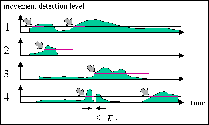Contents of this page are obsolete.
This page is preserved and stored at this URL just from historical viewpoint.
Original URL was http://www.mm.media.kyoto-u.ac.jp/members/kameda/...
Please visit
www.kameda-lab.org
for recent information. (2002/12/06, [email protected])
Publication,
Research,
Docs and Info,
KAMEDA



Next: Experiment
Up: Control and Selection
Previous: Automatic Camera Control
There are generally several criteria to define video clip (cut).
From our experience, we think people want to
see moving objects rather than static objects. And, as more important
insight, we think people prefer to see an object which just starts
moving rather than an object which keeps moving.
So, in our approach, each observation camera sends a request to video
selector to select one of the shoot cameras it is controlling when it
detects movement of an object. Once after the movement is detected and
send the request, it will not send a selection request while the
object keeps moving.
To detect the beginning of the movement, we introduce time parameter
 for an observation camera i.
Suppose a movement is detected on the camera i. In this case, the
camera i does not recognize the beginning of new movement unless
there is a no-motion period longer than
for an observation camera i.
Suppose a movement is detected on the camera i. In this case, the
camera i does not recognize the beginning of new movement unless
there is a no-motion period longer than  seconds.
An example of video selection function is shown in
Figure 3. In this example, there are 4 observation
cameras. The horizontal axes mean time flow, and the vertical axes
indicate motion detection level at each observation camera. A grey
arrow indicates a selection request. If the motion detection level
comes higher than certain threshold value, the request is
generated. In the middle of the sequence in Figure 3,
the camera No.4 cannot generate a request after the video
of the camera No.3 is selected because the beginning of the second
movement is too close (smaller than
seconds.
An example of video selection function is shown in
Figure 3. In this example, there are 4 observation
cameras. The horizontal axes mean time flow, and the vertical axes
indicate motion detection level at each observation camera. A grey
arrow indicates a selection request. If the motion detection level
comes higher than certain threshold value, the request is
generated. In the middle of the sequence in Figure 3,
the camera No.4 cannot generate a request after the video
of the camera No.3 is selected because the beginning of the second
movement is too close (smaller than  ) to the end of the
previous movement.
) to the end of the
previous movement.

Figure 3: Video Selection
Yoshinari Kameda
Tue Oct 5 01:12:48 JST 1999
 for an observation camera i.
Suppose a movement is detected on the camera i. In this case, the
camera i does not recognize the beginning of new movement unless
there is a no-motion period longer than
for an observation camera i.
Suppose a movement is detected on the camera i. In this case, the
camera i does not recognize the beginning of new movement unless
there is a no-motion period longer than  seconds.
An example of video selection function is shown in
Figure 3. In this example, there are 4 observation
cameras. The horizontal axes mean time flow, and the vertical axes
indicate motion detection level at each observation camera. A grey
arrow indicates a selection request. If the motion detection level
comes higher than certain threshold value, the request is
generated. In the middle of the sequence in Figure 3,
the camera No.4 cannot generate a request after the video
of the camera No.3 is selected because the beginning of the second
movement is too close (smaller than
seconds.
An example of video selection function is shown in
Figure 3. In this example, there are 4 observation
cameras. The horizontal axes mean time flow, and the vertical axes
indicate motion detection level at each observation camera. A grey
arrow indicates a selection request. If the motion detection level
comes higher than certain threshold value, the request is
generated. In the middle of the sequence in Figure 3,
the camera No.4 cannot generate a request after the video
of the camera No.3 is selected because the beginning of the second
movement is too close (smaller than  ) to the end of the
previous movement.
) to the end of the
previous movement.
